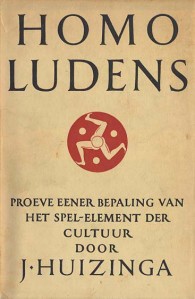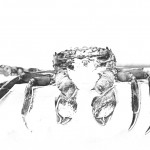Went for a walk, looking for circles - and found a more complex form by…
Huizinga: Homo Ludens
Posted by Everdien on 2/15/10 • Categorized as Admired,All posts
 In 1933, the rector of the University of Leiden, J. Huizinga, chose as the theme of his annual address and subsequent lectures “The Cultural Limits of Play and the Serious”. He took up and developed his topic in an original and very influential work, published in 1938, “Homo Ludens”.
In 1933, the rector of the University of Leiden, J. Huizinga, chose as the theme of his annual address and subsequent lectures “The Cultural Limits of Play and the Serious”. He took up and developed his topic in an original and very influential work, published in 1938, “Homo Ludens”.
‘Homo Ludens’ or ‘Playing Man’ discusses the importance of the play element of culture and society. Huizinga defended the genitive ‘of’ strenuously, as: “… it was not my object to define the place of play among all other manifestations of culture, but rather to ascertain how far culture itself bears the character of play.” [i]
Huizinga qualifies play as being ‘not serious’, but at the same time absorbing the player intensely and utterly. “It is an activity connected with no material interest, and no profit can be gained by it. It proceeds within its own proper boundaries of time and space according to fixed rules and in an orderly manner. It promotes the formation of social groupings which tend to surround themselves with secrecy and to stress their difference from the common world by disguise or other means[ii].”
Huizinga makes short shrift of the idea of humans having an innate ‘play-instinct’, as proposed – amongst others – by Schiller.[iii] For Huizinga, instinctive play is unformed, unstructured, undeveloped. And by inference: uninteresting. He ignores or minimises the psychological aspects of ‘play’ and the many human needs served by play activity.
The main body of his book is devoted to an explanation of how the rules of law, war, philosophy and the arts are derived from ritualistic play. Many of his arguments are linguistic in character – Huizinga exhibits a vast and surprising store of knowledge about the words ‘play’ and ‘game’ in other languages and cultures.
Huizinga’s arguments, when taken from linguistics, often fail to convince. This is particularly the case when Huizinga brings poetry, dance, music and the mimetic play forms from the theatre within the category of ‘play’ by dint of their having to be performed. A piece of music and a theatre play is indeed played. But are the actors performing onstage, is the public, playing? Some essential element of ‘play’ seems missing here – the element of uncertainty, of on-the-spot decisions, of actions causing effects that cannot be determined beforehand.
As for painting, drawing, sculpting, Huizinga finds no ‘play’ elements there.[iv] For Huizinga – child of his time – art is an object, best viewed at a distance. An object neither created while playing, nor enjoyed in play.
[i] Johan Huizinga, Homo Ludens, english translation, foreword, unnumbered page
[ii] Johan Huizinga, Homo Ludens, english translation, page 13
[iii] Schiller in his “Letters on the Aesthetic Education of Man”, 1794
[iv] Johan Huizinga, Homo Ludens, english translation, page 166
Gerelateerd:
-
Complex form
-
Rituals and the rules of war
[youtube]http://www.youtube.com/watch?v=SFwqko-NQXA&feature=youtu.be[/youtube] When at the Barcelona Zoo, I captured this ostrich going at a hopeless task…
| « Some notes about desire | <-- previous post | next post --> | Caillois: Man, Play and Games » |
|---|








